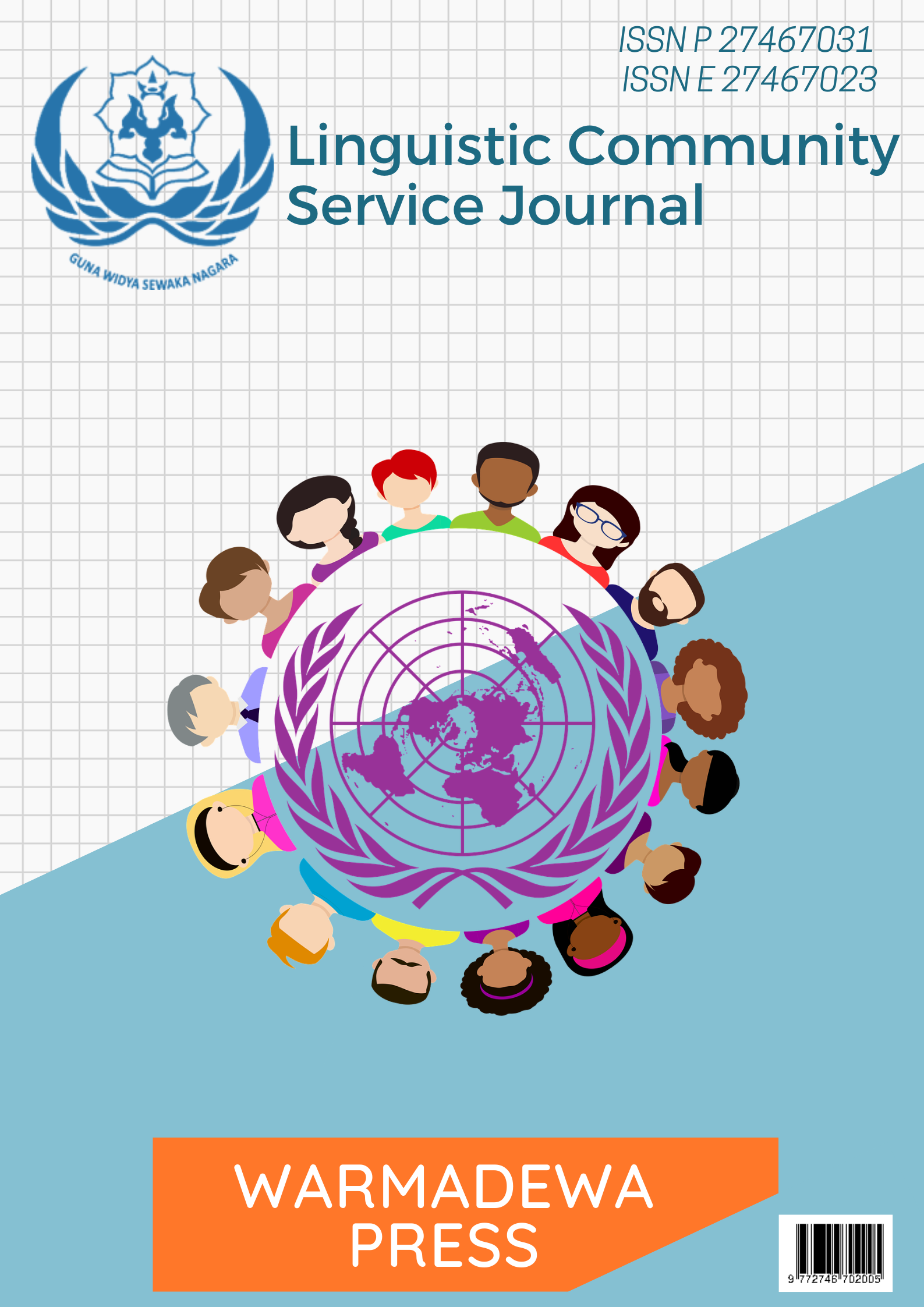Konservasi Bahasa Bali pada Kegiatan Kesubakan di Desa Mambal
Abstract
Over time, the use of regional languages ​​has changed significantly in its use. Given the ever-evolving times, changing mindsets and lifestyles that demand differences from the previous era. Currently the use of mother tongue or Indonesian and English is more desirable in its application due to the demands of an increasingly advanced era. With this phenomenon, the use of regional languages ​​is slowly becoming less attractive, especially the younger generation. To prevent this from happening, a solution is needed, namely by providing teaching or socialization in the form of conservation and revitalization of local languages. The community service program organized by Warmadewa University which aims to educate and increase the interest of the younger generation regarding the preservation of the Balinese language in cultural activities, this also has a relationship with aspects of culture and language. This activity is carried out using a descriptive qualitative method that describes real phenomena that occur in a society. The result of this dedication is that the younger generation shows an interest in fertility activities in order to continue one of the hereditary cultures that has been recognized by the world, namely Subak.
References
Dewi, N. L. A. N. S., Tamba, I. M., & Lestari, P. F. K. (2017). Kinerja Usaha Tani Padi Sawah (Kasus Subak Mambal, Kecamatan Abian Semal). Agrimeta, 7(13), 87–93.
Giri, I. M. A. (2017). Pelestarian Bahasa, Aksara, dan Sastra Bali Melalui Pengoptimalan Tripusat Pendidikan. Purwadita, 1(1), 27–32.
Hasanah, H. (2016). Teknik-Teknik Observasi (Sebuah Alternatif Metode Pengumpulan Data Kualitatif Ilmu-ilmu Sosial). At-Taqaddum, 8(1), 21.
Jha, N., & Schoenfelder, J. W. (2011). Studies of the Subak: New Directions, New Challenges. Human Ecology, 39(1), 3–10.
Mustika, I. K. (2018). Pergeseran Bahasa Bali sebagai Bahasa Ibu di Era Global (Kajian Pemertahanan Bahasa). Purwadita, 2(1), 94–102.
Nirmalasari. (2017). Ekoleksikon Ke-Kaghati-An Bahasa Muna. RETORIKA: Jurnal Ilmu Bahasa, 2(2), 328–349.
Nugroho, P. (2018). Tripusat Pendidikan sebagai Basis Sosialisasi dan Pembentukan Karakter Siswa. Ijtimaiya: Journal of Social Science Teaching Volume, 2(1), 1689–1699.
Roth, D. (2011). The Subak in Diaspora: Balinese Farmers and the Subak in South Sulawesi. Human Ecology, 39(1), 55–68.
Salamanca, A. M., Nugroho, A., Osbeck, M., Bharwani, S., & Dwisasanti, N. (2015). Managing a Living Cultural Landscape : Lessons and Insights from the Subaks of Bali , a UNESCO World Heritage Site. In Stockholm Environment Insitute. Stockholm Environment Institute.
Tondo, F. H. (2009). Kepunahan Bahasa-Bahasa Daerah: Faktor Penyebab dan Implikasi Etnolinguistis. Jurnal Masyarakat & Budaya, 1(2), 277–296.
Widianto, E. (2018). Pemertahanan Bahasa Daerah melalui Pembelajaran dan Kegiatan di Sekolah. Jurnal Kredo, 1(2), 1–13.
Windia, W., Sumiyati, S., & Sedana, G. (2015). Aspek Ritual pada Sistem Irigasi Subak sebagai Warisan Budaya Dunia. Jurnal Kajian Bali (Journal of Bali Studies), 5(1), 23–56.
Yekti, M. I. (2017). Role of Reservoir Operation in Sustainable Water Supply to Subak Irrigation Schemes in Yeh Ho River Basin. In Taylor & Francis Group.
Copyright (c) 2021 Linguistic Community Services Journal

This work is licensed under a Creative Commons Attribution-ShareAlike 4.0 International License.
This journal provides immediate open access to its content on the principle that making research freely available to the public supports a greater global exchange of knowledge.
All articles published Open Access will be immediately and permanently free for everyone to read and download. We are continuously working with our author communities to select the best choice of license options, currently being defined for this journal as follows: Creative Commons-Non Ceomercial-Attribution-ShareAlike (CC BY-NC-SA)
 Abstract viewed = 334 times
Abstract viewed = 334 times
 PDF (Bahasa Indonesia) downloaded = 368 times
PDF (Bahasa Indonesia) downloaded = 368 times














